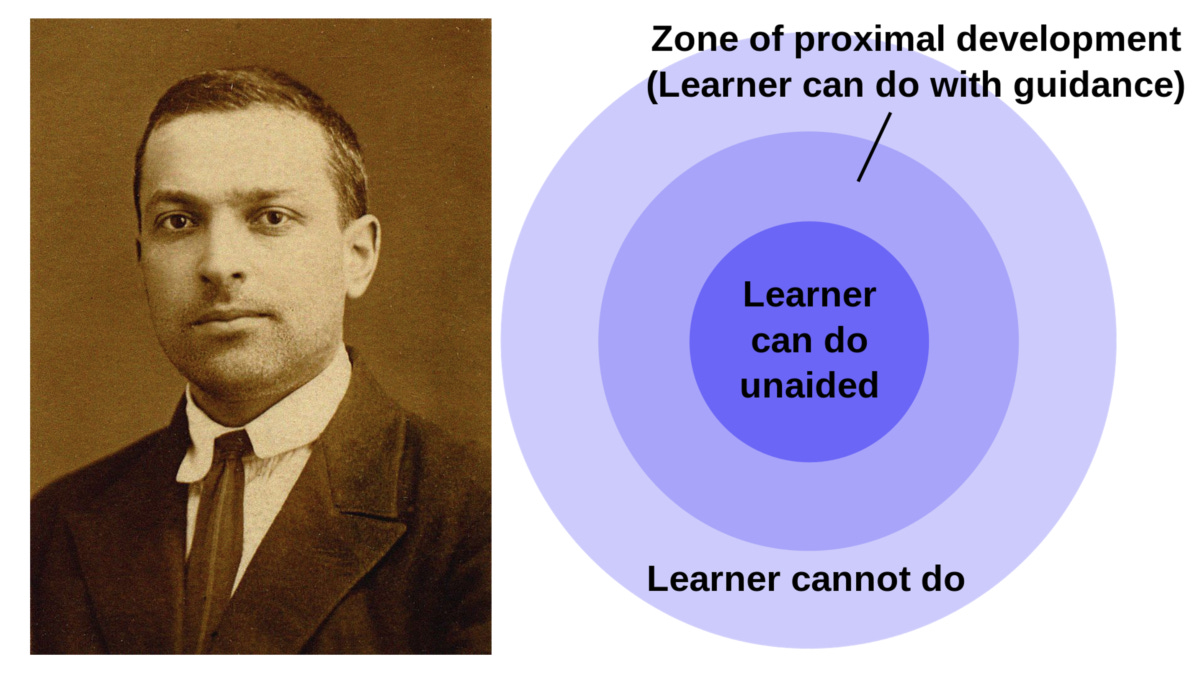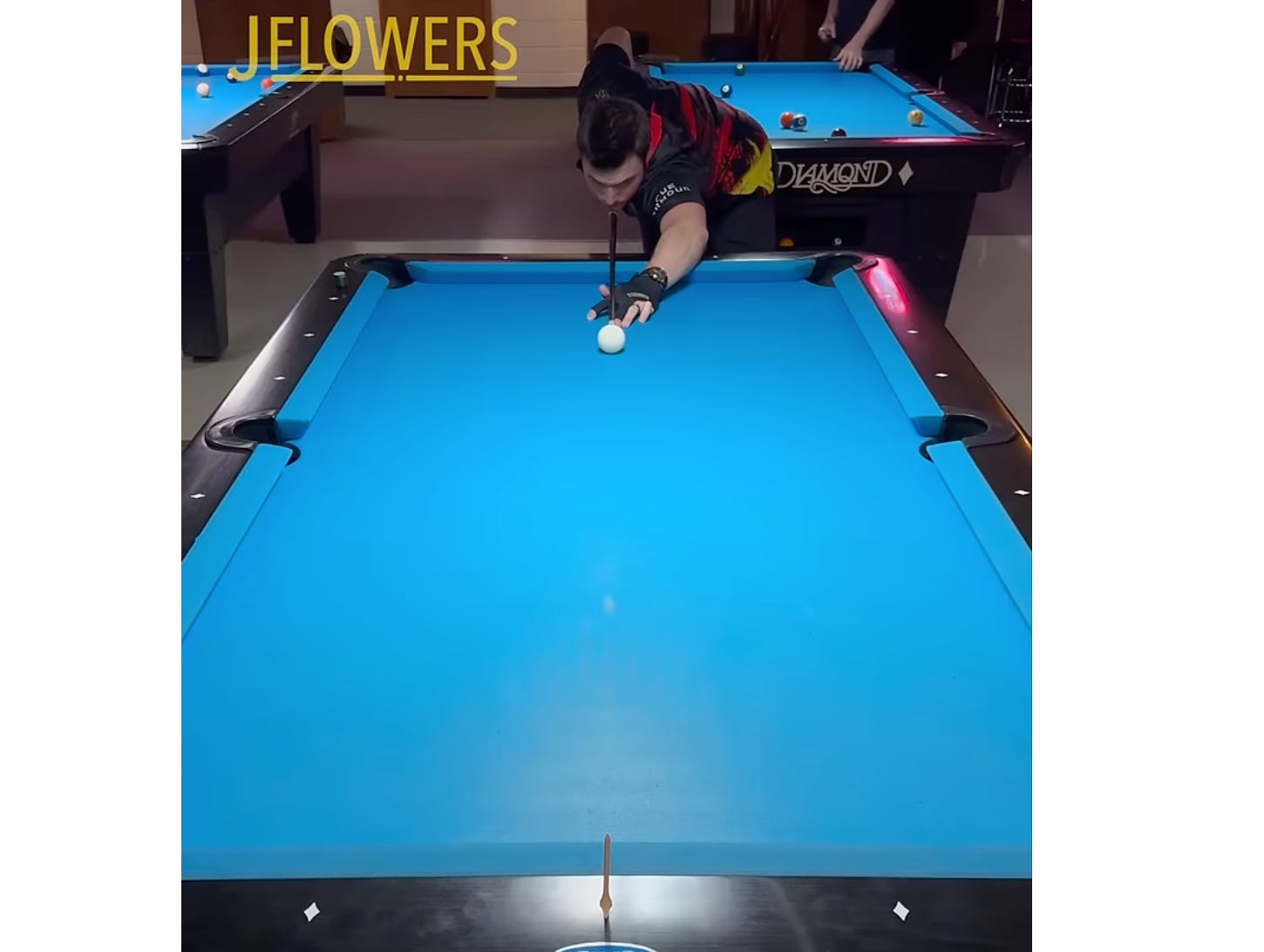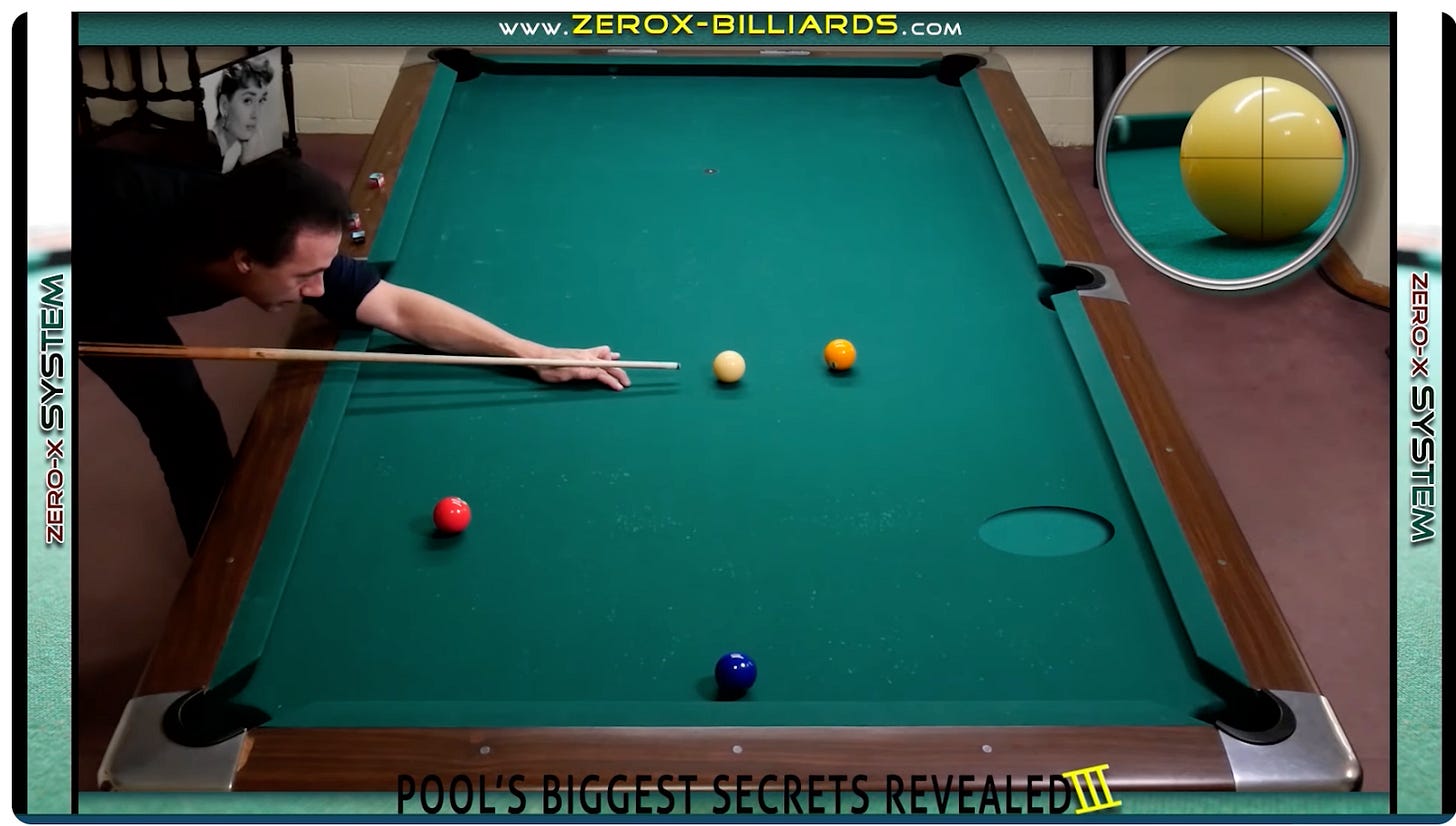YouTube is overflowing with videos about how to play pool — but if you don’t know what to practice, all that content can be overwhelming. So how do you find the sweet spot—the shots and drills that truly move your game forward?
In the last post on ‘deliberate practice,’ we looked at the work of Anders Ericsson and how to design practice sessions in a way that helps people break through the intermediate plateau (Ex. isolating specific skills, get feedback, make adjustments, and develop understanding in a systematic way).
In this post, we’ll think about what practice exercises to do and why sequencing them is important.
Adjusting the Challenge Level
Last time, we looked at the ‘Mighty X’ drill—an example of deliberate practice that helps players develop a straight, smooth stroke. The goal is to sink the object ball with a stop shot, where the cue ball halts upon contact. If the stroke is off, the cue ball drifts to the side, providing immediate feedback.
(Image from Shortstop on Pool video)
During my own practice, I’ve been adjusting the difficulty using a progressive drill—by moving the cue ball closer or further from the object ball.
(Image from PoolDawg website)
This strategy can be applied to any exercise and is key to avoiding frustration in pool exercises. Rather than pounding away at the same drill which is too hard for you, it is helpful to think about ways of making it easier (ex. moving the ball closer, lessening the angle, taking it off the rail, etc), mastering that, and then gradually increasing the difficulty.
The Zone of Proximal Development
To practice efficiently, you need to find the right level of challenge. Soviet psychologist Lev Vygotsky called this the Zone of Proximal Development (ZPD)—tasks that are just beyond your current ability, but achievable with practice and support.
(Image from WhyITeach blog)
Focusing on Fundamentals First
For beginners, the full Mighty X drill may be too difficult and discouraging. Many haven’t yet built the foundational skills—like a stable stance, proper grip, a smooth stroke, or a solid bridge.
Top coaches recommend starting with drills that emphasize fundamentals. Ron “The Pool Student” promotes an approach that focuses on simply hitting the cue ball into a pocket with proper technique.
(Image from Ron, The Pool Student’s video “Why Players Never Improve”)
Another option is a cue ball return drill—where you hit the cue ball straight up the table and try to get it to return to your stick. Even a slight spin will send it off course as it returns.
(Image from YouTube video ‘3 Ways to See How Straight Your Stroke is.” by MagicMikeBilliards)
Looking back, I realize I would have progressed faster if I had started with these drills. Instead, I jumped into complex shots without developing consistency—and my stroke paid the price. It was only in the last year that I returned to fundamentals and had to unlearn bad habits.
Creating a Sequence of Practice Exercises
Finding the right practice sequence is like crossing a river on stepping stones—too far apart, and you might fall; too close, and it's boring.
(Image from ‘Understanding Teaching through Learning’)
Some of the giants in education and the Science of Learning elaborate on this idea:
Anders Ericsson (see previous post on deliberate practice) explains:
“The instructor has to organize the sequence of appropriate training tasks and monitor improvement to decide when transitions to more complex and challenging tasks are appropriate.”
Educator Lee Shulman also emphasized the teacher’s role in guiding learners through a well-planned path. His idea of Pedagogical Content Knowledge (PCK) combines deep subject knowledge with an ability to teach effectively (check out the link below for a summary of his amazing work!).
(Image from YouTube Video ‘What Makes Teachers Special? - Pedagogical Content Knowledge’ by 3 Minute Ed Theory)
For example, a skilled pool teacher can explain abstract concepts and guide students through a sequence of exercises that build confidence and skill.
In other words, if you want to study in a smart, efficient way, it is important to follow a carefully designed sequence of subtasks (i.e. practice exercises) especially at the lower levels.
After lower level pool players build up their basic skills, there can be much more flexibility and choice in the types of shots and practice exercises that they do, but especially in the beginning, there are sequences of practice exercises and subtasks that build upon one another and will accelerate learning.
The dangers of skipping ahead
New players often apply left/right spin (AKA English) too early—either accidentally due to a problem with their stroke, or intentionally by copying advanced players. But spin changes how the cue ball contacts the object ball and can throw off aim if players don’t understand how to adjust the aim and compensate for spin. It is actually quite complex!
Check out this excellent video ‘How to Aim with Sidespin’ by YouTube creator, Sharivari for examples and explanations.
When players don’t understand these complexities and start putting spin on the ball too early, they can actually stunt their growth. They often end up missing because they don't understand how the spin affects the aim point – they miss but don’t know why.
Learning how to hit center-ball shots first (including top and bottom spin) helps build stroke consistency. Misusing English can lead to frustration and bad habits that are hard to break.
(Image from The Pool Coach)
Balancing Your Practice
Another issue is focusing too much on a single skill—like shot-making—while ignoring others like position play or strategy. As we saw in earlier posts about KASA (knowledge, awareness, skills, and attitude), it is also important to develop awareness, which in this case involves understanding the path of the cue ball and working on strategy.
Tor Lowry, a noted pool teacher and YouTube creator, has created ingenious drills that use only center-ball hits, helping players focus on speed, angles, and decision-making. In this practice, Tor first invites the viewer to take ball-in-hand (i.e. place the cue ball anywhere on the table) and come up with a plan to hit the three balls in. He then explains his thought process and demonstrates how to run out the 1 (yellow), 2 (blue), and 3 (red) in order by just hitting center-ball shots.
(Image from Tor Lowry’s video “Drills to Sharpen your 8-ball/9-ball Game”
Notice how he has marked the spot where he wants the cue ball to end up after making the relatively easy shot on the one ball. The challenge here is knowing where to place the cue ball so that the natural angle takes it to that spot. In addition, students have to practice shot speed so that they can get the cue ball in the right area for the next shot on the 2. This is an effective way to practice:
Pattern play (choosing the right shot sequence)
Position play & Cue ball control (moving the cue ball effectively to set up for the next shot)
When these skills are honed, players can avoid difficult shots – opting instead for smart, simple positioning. What’s great about these exercises that Tor designed is that they can be done relatively early on with lower level players because they just use center-ball and do not require left/right spin.
Summing It Up
When learning a skill, it’s important to think about both how you practice and what you practice.
The “How” = Deliberate Practice
Break pool into challenging but manageable subtasks
Focus attention during systematic training
Get feedback (make/miss + feedback on stance/stroke)
Build mental representations (getting visual in your mind’s eye and a ‘feel’ for the shot)
The “What” = Choosing the Right Tasks
Start with fundamental skills (stance, grip, bridge, stroke)
Use progressive drills to scale difficulty
Sequence skills so each builds on the last
Balance your practice: shot-making, pattern play, position play
Too many players (myself included!) waste time on ineffective drills or skip ahead to advanced techniques. But with thoughtful sequencing (informed by a teacher with Pedagogical Content Knowledge - PCK!) and a clear focus, improvement comes faster—and with less frustration.
Let’s Reflect
👍 If you enjoyed this post, I always appreciate a ‘like’—and I always welcome comments!
For pool players: Do you agree with the ideas above? What do you think is important in developing, sequencing, or balancing practice exercises in pool?
For teachers and learners: Do you see these same ideas in other domains? How do you decide what to practice and when?
References
Ericsson, K. A., et al. (1993). The Role of Deliberate Practice in the Acquisition of Expert Performance.
Kurzweil, J. (2006). Understanding Teaching through Learning. McGraw-Hill.
“What Makes Teachers Special? - Pedagogical Content Knowledge.” 3 Minute Ed Theory.
Pool Videos mentioned aboveMagicMikeBilliards’ ‘3 Ways to See How Straight Your Stroke is.”
Ron, The Pool Student’s video “Why Players Never Improve”
Sharivari’s video ‘How to Aim with Sidespin’ (for intermediate/advanced players!)
Tor Lowry’s video “Drills to Sharpen your 8-ball/9-ball Game”












Re: what to practice
In disciplines where i have had (relatively) recent coaching (pool, tennis, Pickleball), i have found it invaluable to have an insightful coach/mentor who can identify weaknesses that are in my blind spots - and identify and prioritize drills that i didn’t realize i needed.
There are sometimes exercises (as an alternative or supplement to coaching) that can expose those weaknesses For example Bob Jewett has some progressive run out drills for a pool. Doing those I found that I was often failing in similar situations (e.g. shooting when the cue ball was on a rail and i therefore needed a different, more awkward bridge). I spent years practicing pool without ever doing focused practice on that skill.
I often find people are blind to there biggest addressable weakness